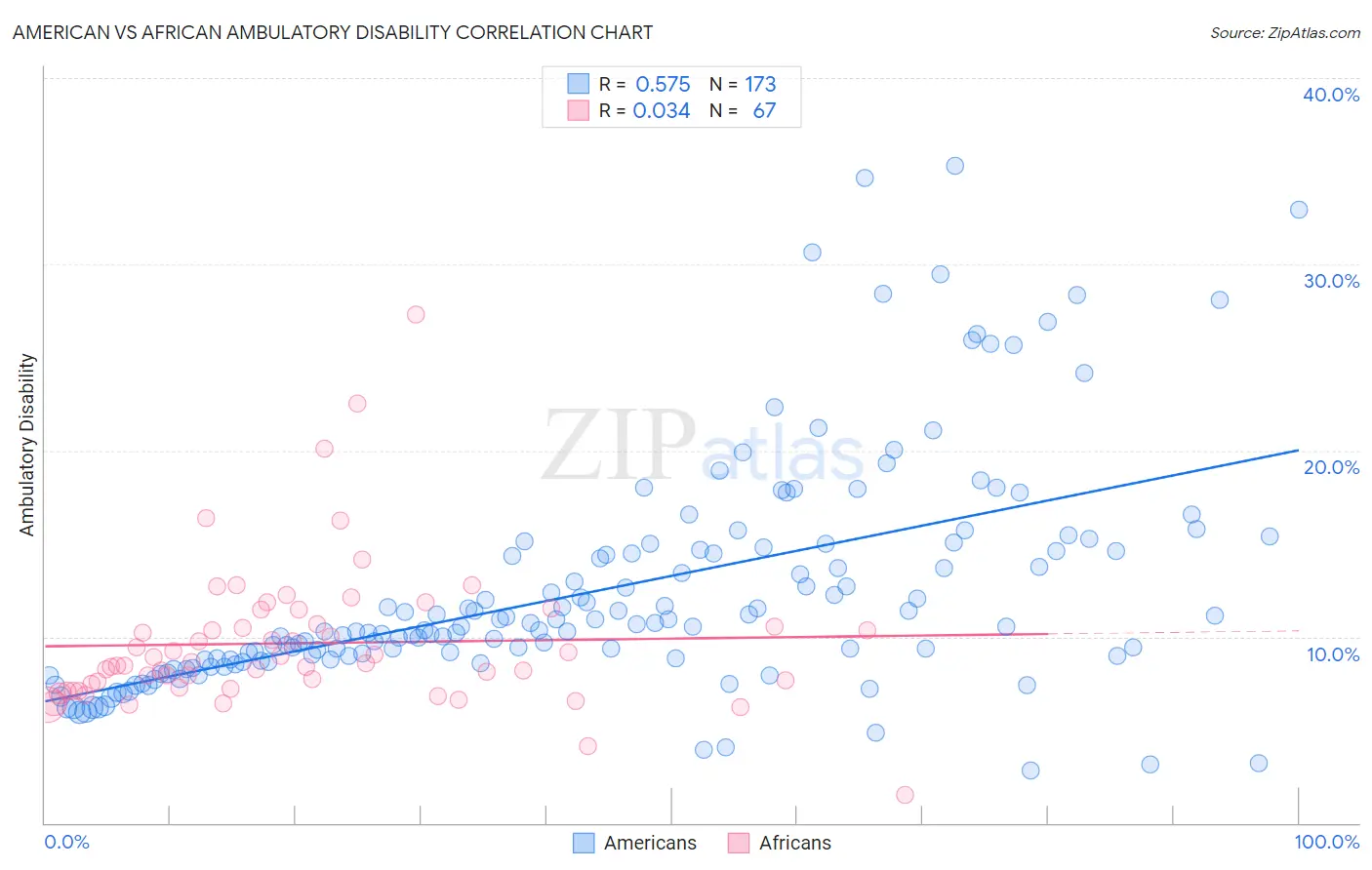American vs African Ambulatory Disability
COMPARE
American
African
Ambulatory Disability
Ambulatory Disability Comparison
Americans
Africans
7.4%
AMBULATORY DISABILITY
0.0/ 100
METRIC RATING
323rd/ 347
METRIC RANK
7.0%
AMBULATORY DISABILITY
0.0/ 100
METRIC RATING
303rd/ 347
METRIC RANK
American vs African Ambulatory Disability Correlation Chart
The statistical analysis conducted on geographies consisting of 581,324,022 people shows a substantial positive correlation between the proportion of Americans and percentage of population with ambulatory disability in the United States with a correlation coefficient (R) of 0.575 and weighted average of 7.4%. Similarly, the statistical analysis conducted on geographies consisting of 469,824,822 people shows no correlation between the proportion of Africans and percentage of population with ambulatory disability in the United States with a correlation coefficient (R) of 0.034 and weighted average of 7.0%, a difference of 6.3%.

Ambulatory Disability Correlation Summary
| Measurement | American | African |
| Minimum | 2.8% | 1.5% |
| Maximum | 35.3% | 27.3% |
| Range | 32.5% | 25.7% |
| Mean | 12.5% | 9.7% |
| Median | 10.5% | 8.6% |
| Interquartile 25% (IQ1) | 8.8% | 7.3% |
| Interquartile 75% (IQ3) | 14.6% | 10.6% |
| Interquartile Range (IQR) | 5.9% | 3.4% |
| Standard Deviation (Sample) | 6.2% | 3.9% |
| Standard Deviation (Population) | 6.1% | 3.9% |
Demographics Similar to Americans and Africans by Ambulatory Disability
In terms of ambulatory disability, the demographic groups most similar to Americans are Osage (7.4%, a difference of 0.28%), Apache (7.4%, a difference of 0.42%), Potawatomi (7.3%, a difference of 1.2%), Dominican (7.2%, a difference of 3.1%), and Ottawa (7.2%, a difference of 3.5%). Similarly, the demographic groups most similar to Africans are Immigrants from Cabo Verde (7.0%, a difference of 0.36%), Immigrants from Micronesia (7.0%, a difference of 0.64%), Iroquois (7.1%, a difference of 1.2%), Spanish American (7.1%, a difference of 1.4%), and Chippewa (7.1%, a difference of 1.5%).
| Demographics | Rating | Rank | Ambulatory Disability |
| Africans | 0.0 /100 | #303 | Tragic 7.0% |
| Immigrants | Cabo Verde | 0.0 /100 | #304 | Tragic 7.0% |
| Immigrants | Micronesia | 0.0 /100 | #305 | Tragic 7.0% |
| Iroquois | 0.0 /100 | #306 | Tragic 7.1% |
| Spanish Americans | 0.0 /100 | #307 | Tragic 7.1% |
| Chippewa | 0.0 /100 | #308 | Tragic 7.1% |
| Immigrants | Azores | 0.0 /100 | #309 | Tragic 7.1% |
| Arapaho | 0.0 /100 | #310 | Tragic 7.1% |
| Cree | 0.0 /100 | #311 | Tragic 7.1% |
| Delaware | 0.0 /100 | #312 | Tragic 7.1% |
| Immigrants | Yemen | 0.0 /100 | #313 | Tragic 7.1% |
| Blackfeet | 0.0 /100 | #314 | Tragic 7.1% |
| Shoshone | 0.0 /100 | #315 | Tragic 7.1% |
| Immigrants | Dominican Republic | 0.0 /100 | #316 | Tragic 7.1% |
| Central American Indians | 0.0 /100 | #317 | Tragic 7.2% |
| Ottawa | 0.0 /100 | #318 | Tragic 7.2% |
| Dominicans | 0.0 /100 | #319 | Tragic 7.2% |
| Potawatomi | 0.0 /100 | #320 | Tragic 7.3% |
| Apache | 0.0 /100 | #321 | Tragic 7.4% |
| Osage | 0.0 /100 | #322 | Tragic 7.4% |
| Americans | 0.0 /100 | #323 | Tragic 7.4% |